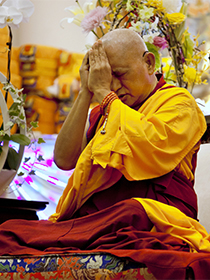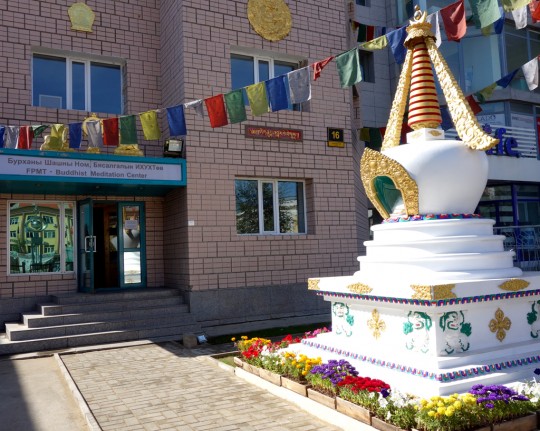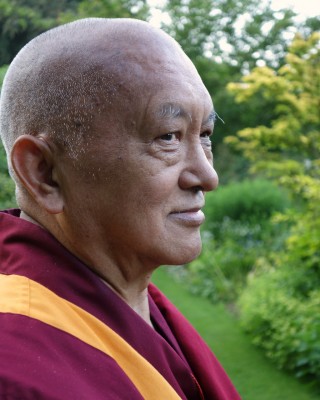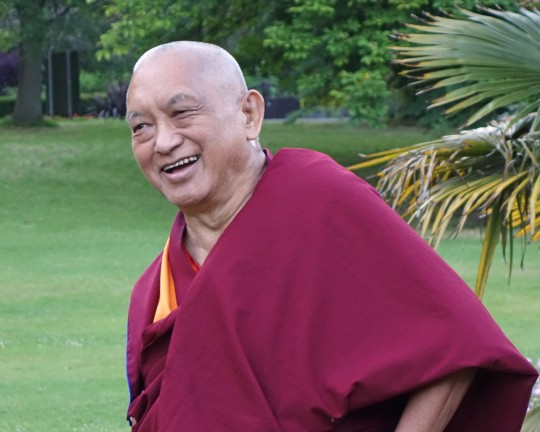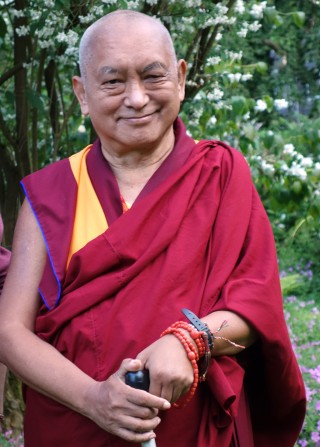- Home
- FPMT Homepage
Foundation for the Preservation of the Mahayana Tradition
The FPMT is an organization devoted to preserving and spreading Mahayana Buddhism worldwide by creating opportunities to listen, reflect, meditate, practice and actualize the unmistaken teachings of the Buddha and based on that experience spreading the Dharma to sentient beings. We provide integrated education through which people’s minds and hearts can be transformed into their highest potential for the benefit of others, inspired by an attitude of universal responsibility and service. We are committed to creating harmonious environments and helping all beings develop their full potential of infinite wisdom and compassion. Our organization is based on the Buddhist tradition of Lama Tsongkhapa of Tibet as taught to us by our founders Lama Thubten Yeshe and Lama Thubten Zopa Rinpoche.
- Willkommen
Die Stiftung zur Erhaltung der Mahayana Tradition (FPMT) ist eine Organisation, die sich weltweit für die Erhaltung und Verbreitung des Mahayana-Buddhismus einsetzt, indem sie Möglichkeiten schafft, den makellosen Lehren des Buddha zuzuhören, über sie zur reflektieren und zu meditieren und auf der Grundlage dieser Erfahrung das Dharma unter den Lebewesen zu verbreiten.
Wir bieten integrierte Schulungswege an, durch denen der Geist und das Herz der Menschen in ihr höchstes Potential verwandelt werden zum Wohl der anderen – inspiriert durch eine Haltung der universellen Verantwortung und dem Wunsch zu dienen. Wir haben uns verpflichtet, harmonische Umgebungen zu schaffen und allen Wesen zu helfen, ihr volles Potenzial unendlicher Weisheit und grenzenlosen Mitgefühls zu verwirklichen.
Unsere Organisation basiert auf der buddhistischen Tradition von Lama Tsongkhapa von Tibet, so wie sie uns von unseren Gründern Lama Thubten Yeshe und Lama Thubten Zopa Rinpoche gelehrt wird.
- Bienvenidos
La Fundación para la preservación de la tradición Mahayana (FPMT) es una organización que se dedica a preservar y difundir el budismo Mahayana en todo el mundo, creando oportunidades para escuchar, reflexionar, meditar, practicar y actualizar las enseñanzas inconfundibles de Buda y en base a esa experiencia difundir el Dharma a los seres.
Proporcionamos una educación integrada a través de la cual las mentes y los corazones de las personas se pueden transformar en su mayor potencial para el beneficio de los demás, inspirados por una actitud de responsabilidad y servicio universales. Estamos comprometidos a crear ambientes armoniosos y ayudar a todos los seres a desarrollar todo su potencial de infinita sabiduría y compasión.
Nuestra organización se basa en la tradición budista de Lama Tsongkhapa del Tíbet como nos lo enseñaron nuestros fundadores Lama Thubten Yeshe y Lama Zopa Rinpoche.
A continuación puede ver una lista de los centros y sus páginas web en su lengua preferida.
- Bienvenue
L’organisation de la FPMT a pour vocation la préservation et la diffusion du bouddhisme du mahayana dans le monde entier. Elle offre l’opportunité d’écouter, de réfléchir, de méditer, de pratiquer et de réaliser les enseignements excellents du Bouddha, pour ensuite transmettre le Dharma à tous les êtres. Nous proposons une formation intégrée grâce à laquelle le cœur et l’esprit de chacun peuvent accomplir leur potentiel le plus élevé pour le bien d’autrui, inspirés par le sens du service et une responsabilité universelle. Nous nous engageons à créer un environnement harmonieux et à aider tous les êtres à épanouir leur potentiel illimité de compassion et de sagesse. Notre organisation s’appuie sur la tradition guéloukpa de Lama Tsongkhapa du Tibet, telle qu’elle a été enseignée par nos fondateurs Lama Thoubtèn Yéshé et Lama Zopa Rinpoché.
Visitez le site de notre Editions Mahayana pour les traductions, conseils et nouvelles du Bureau international en français.
Voici une liste de centres et de leurs sites dans votre langue préférée
- Benvenuto
L’FPMT è un organizzazione il cui scopo è preservare e diffondere il Buddhismo Mahayana nel mondo, creando occasioni di ascolto, riflessione, meditazione e pratica dei perfetti insegnamenti del Buddha, al fine di attualizzare e diffondere il Dharma fra tutti gli esseri senzienti.
Offriamo un’educazione integrata, che può trasformare la mente e i cuori delle persone nel loro massimo potenziale, per il beneficio di tutti gli esseri, ispirati da un’attitudine di responsabilità universale e di servizio.
Il nostro obiettivo è quello di creare contesti armoniosi e aiutare tutti gli esseri a sviluppare in modo completo le proprie potenzialità di infinita saggezza e compassione.
La nostra organizzazione si basa sulla tradizione buddhista di Lama Tsongkhapa del Tibet, così come ci è stata insegnata dai nostri fondatori Lama Thubten Yeshe e Lama Zopa Rinpoche.
Di seguito potete trovare un elenco dei centri e dei loro siti nella lingua da voi prescelta.
- 欢迎 / 歡迎
简体中文
“护持大乘法脉基金会”( 英文简称:FPMT。全名:Foundation for the Preservation of the Mahayana Tradition) 是一个致力于护持和弘扬大乘佛法的国际佛教组织。我们提供听闻,思维,禅修,修行和实证佛陀无误教法的机会,以便让一切众生都能够享受佛法的指引和滋润。
我们全力创造和谐融洽的环境, 为人们提供解行并重的完整佛法教育,以便启发内在的环宇悲心及责任心,并开发内心所蕴藏的巨大潜能 — 无限的智慧与悲心 — 以便利益和服务一切有情。
FPMT的创办人是图腾耶喜喇嘛和喇嘛梭巴仁波切。我们所修习的是由两位上师所教导的,西藏喀巴大师的佛法传承。
繁體中文
護持大乘法脈基金會”( 英文簡稱:FPMT。全名:Found
ation for the Preservation of the Mahayana Tradition ) 是一個致力於護持和弘揚大乘佛法的國際佛教組織。我們提供聽聞, 思維,禪修,修行和實證佛陀無誤教法的機會,以便讓一切眾生都能 夠享受佛法的指引和滋潤。 我們全力創造和諧融洽的環境,
為人們提供解行並重的完整佛法教育,以便啟發內在的環宇悲心及責 任心,並開發內心所蘊藏的巨大潛能 — 無限的智慧與悲心 – – 以便利益和服務一切有情。 FPMT的創辦人是圖騰耶喜喇嘛和喇嘛梭巴仁波切。
我們所修習的是由兩位上師所教導的,西藏喀巴大師的佛法傳承。 察看道场信息:
- FPMT Homepage
- News/Media
-
- Study & Practice
-
-
- About FPMT Education Services
- Latest News
- Programs
- New to Buddhism?
- Buddhist Mind Science: Activating Your Potential
- Heart Advice for Death and Dying
- Discovering Buddhism
- Living in the Path
- Exploring Buddhism
- FPMT Basic Program
- FPMT Masters Program
- FPMT In-Depth Meditation Training
- Maitripa College
- Lotsawa Rinchen Zangpo Translator Program
- Universal Education for Compassion & Wisdom
- Online Learning Center
-
- Prayers & Practice Materials
- Overview of Prayers & Practices
- Full Catalogue of Prayers & Practice Materials
- Explore Popular Topics
- Benefiting Animals
- Chenrezig Resources
- Death & Dying Resources
- Lama Chopa (Guru Puja)
- Lama Zopa Rinpoche: Compendium of Precious Instructions
- Lama Zopa Rinpoche: Life Practice Advice
- Lama Zopa Rinpoche Practice Series
- Lamrim Resources
- Mantras
- Prayer Book Updates
- Purification Practices
- Sutras
- Thought Transformation (Lojong)
- Audio Materials
- Dharma Dates - Tibetan Calendar
- Translation Services
- Publishing Services
- Ways to Offer Support
- Prayers & Practice Materials
-
- Teachings and Advice
- Find Teachings and Advice
- Lama Zopa Rinpoche Advice Page
- Lama Zopa Rinpoche: Compendium of Precious Instructions
- Lama Zopa Rinpoche Video Teachings
- ༧སྐྱབས་རྗེ་བཟོད་པ་རིན་པོ་ཆེ་མཆོག་ནས་སྩལ་བའི་བཀའ་སློབ་བརྙན་འཕྲིན།
- Podcasts
- Lama Yeshe Wisdom Archive
- Buddhism FAQ
- Dharma for Young People
- Resources on Holy Objects
- Teachings and Advice
-
-
*If a menu item has a submenu clicking once will expand the menu clicking twice will open the page.
-
-
- Centers
-
- Teachers
-
- Projects
-
-
-
-
*If a menu item has a submenu clicking once will expand the menu clicking twice will open the page.
-
-
- FPMT
-
-
-
-
-
To meet the challenge of our times, human beings will have to develop a greater sense of universal responsibility. Each of us must learn to work not just for his or her own self, family or nation, but for all.
His Holiness the Dalai Lama
-
-
-
- Shop
-
-
-
The Foundation Store is FPMT’s online shop and features a vast selection of Buddhist study and practice materials written or recommended by our lineage gurus. These items include homestudy programs, prayers and practices in PDF or eBook format, materials for children, and other resources to support practitioners.
Items displayed in the shop are made available for Dharma practice and educational purposes, and never for the purpose of profiting from their sale. Please read FPMT Foundation Store Policy Regarding Dharma Items for more information.
-
-
Lama Zopa Rinpoche News
3
Light of the Path 2014 Teachings Now Available Online!
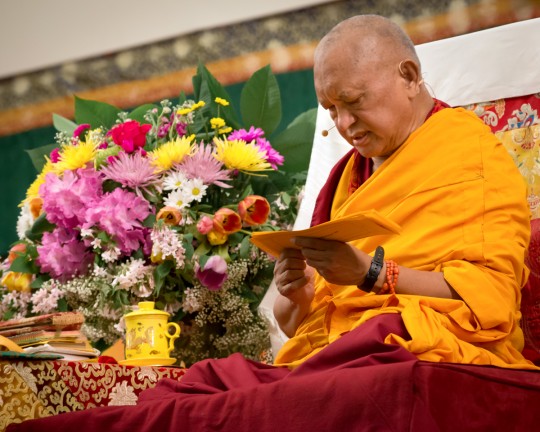
Lama Zopa Rinpoche teaching at Light of the Path retreat, North Carolina, US, May 2014. Photo by Roy Harvey.
Video from the 2014 Light of the Path retreat can be watched online on fpmt.org. You can find the video recordings of the teachings with Lama Zopa Rinpoche as well as some of the review sessions with titles, descriptions and translations in English, French and Spanish on FPMT’s “2014 Light of the Path Teachings” page.
Transcripts from the teachings are available as a PDF in English. Audio MP3s from the teachings are also available in English, French and Spanish. And videos from the 2009 and 2010 Light of the Path teachings can be found on FPMT’s Online Learning Center.
The Light of the Path retreats are organized by Kadampa Center in Black Mountain, North Carolina, US, and have taken place in 2009, 2010 and 2014. The root text for the retreats is Lama Atisha’s Lamp for the Path to Enlightenment.
The direct links to these precious lam-rim teachings are:
- 2014 Video Recordings: https://fpmt.org/media/streaming/teachings-of-lama-zopa-rinpoche/light-of-the-path-teachings/
- 2009 and 2010 Video Recordings: http://onlinelearning.fpmt.org/mod/page/view.php?id=484
- Resources Area for MP3 and Transcripts Downloads: http://onlinelearning.fpmt.org/mod/page/view.php?id=484
Lama Zopa Rinpoche is the spiritual director of the Foundation for the Preservation of Mahayana Tradition (FPMT), a Tibetan Buddhist organization dedicated to the transmission of the Mahayana Buddhist tradition and values worldwide through teaching, meditation and community service.
- Tagged: lama zopa rinpoche, light of the path, mandala, video
- 0
29
Lama Zopa Rinpoche Teaches in Mongolia during 100 Million Mani Retreat

Lama Zopa Rinpoche at the 100 Million Mani retreat, Idgaa Choizinling Dratsang, Ganden Monastery, Ulaanbaatar, Mongolia, August 2014. Photo by Ven. Roger Kunsang.
Lama Zopa Rinpoche arrived in Mongolia earlier this week for the 100 Million Mani retreat organized by FPMT Mongolia. The retreat, which is being held at Idgaa Choizinling Dratsang, Gandan Monastery in Ulaanbaatar, began on August 17 and runs through September 18. This is the second year of the retreat. Rinpoche is teaching at the retreat August 27-September 1.
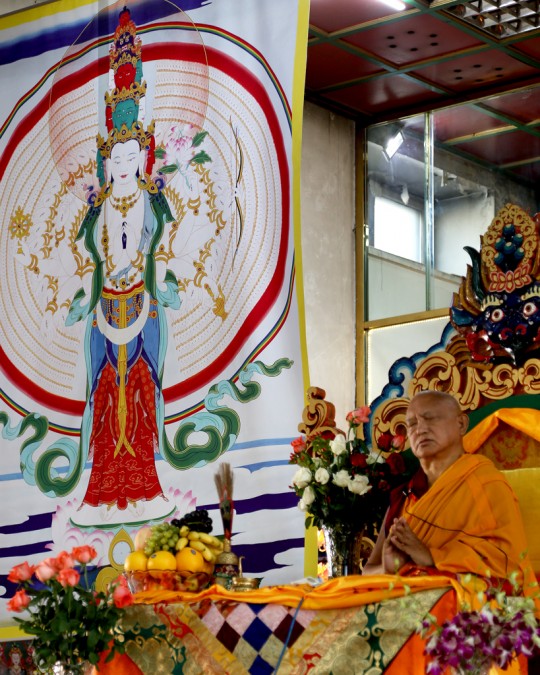
Lama Zopa Rinpoche teaching at the 100 Million Mani retreat, Ulaanbaatar, Mongolia, August 2014. Photo by Ven. Roger Kunsang.
Last year several hundred Mongolians and about 70 non-Mongolians attended the retreat, which was regarded as a complete success. A total of 108,939,500 mani mantras were recited. Rinpoche appeared very pleased with the retreat and requested that it be done every year.
FPMT Mongolia has several centers and activities in Mongolia, including Ganden Do Ngag Shedrup Ling, the center located in central Ulaanbaatar, and Golden Light Sutra Center in Darkhan. FPMT Mongolia also oversees Drolma Ling Nunnery in Ulaanbaatar and several other socially focused programs.
You can find more stories and photos from the 100 Million Mani Retreat in Mongolia and on FPMT Mongolia on Mandala.
Mandala brings you news of Lama Zopa Rinpoche and FPMT activities, teachers and events from over 160 FPMT centers, projects and services around the globe. If you have news you would like to share, please let us know.
28
Creating Peace in the World
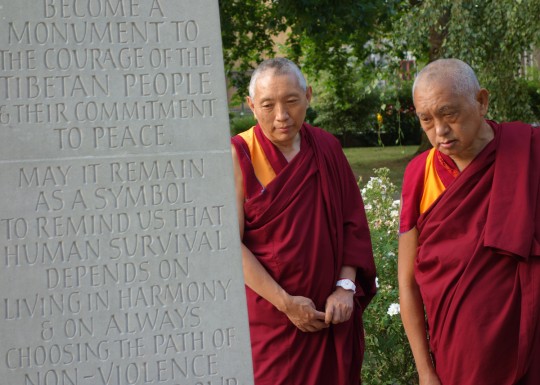
Lama Zopa Rinpoche with Geshe Tashi, resident geshe at Jamyang Buddhist Centre, visiting the the Tibetan Peace Garden next to the Imperial War Museum in London, UK, July 2014. Photo by Ven. Roger Kunsang.
Lama Zopa Rinpoche has offered much advice on creating peace in the world. You can find much of this advice posted on the “Lama Zopa Rinpoche Advice” page on fpmt.org.
Rinpoche encourages students to recite the Golden Light Sutra to help create the causes of peace. Of its benefits, Rinpoche said, ”The holy Golden Light Sutra is the king of the sutras. It is extremely powerful and fulfills all one’s wishes, as well as bringing peace and happiness for all sentient beings, up to enlightenment. It is also extremely powerful for world peace, for your own protection and for the protection of the country and the world. Also, it has great healing power for people in the country.”
Lama Zopa Rinpoche is the spiritual director of the Foundation for the Preservation of Mahayana Tradition (FPMT), a Tibetan Buddhist organization dedicated to the transmission of the Mahayana Buddhist tradition and values worldwide through teaching, meditation and community service.
- Tagged: lama zopa rinpoche, peace
- 0
27
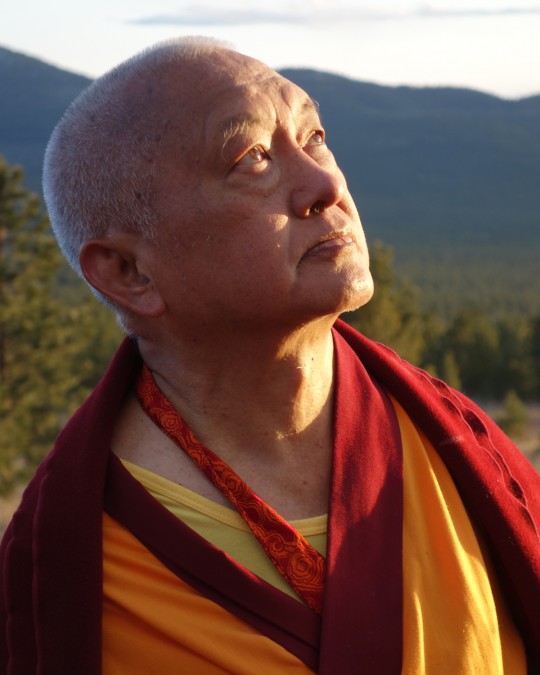
Lama Zopa Rinpoche at Buddha Amitabha Pure Land, Washington, US, April 2014. Photo Ven. Roger Kunsang.
“When you have in mind the thought that death can come today, if something suddenly happens, it is not a shock,” Lama Zopa Rinpoche instructs in his book Bodhisattva Attitude: How to Dedicate Your Life to Others. “It is not a shock at all because your mind is prepared. You have already trained your mind by thinking very strongly about death first thing every morning and keeping that awareness throughout the day. That helps you to be at peace and not have fear when you face a life-threatening problem or something similar.
“If your mind has not become Dharma because you haven’t trained in the thought of impermanence but instead have always thought, ‘I am going to live for a long time,’ and done all your activities with attachment to this life, then if something opposite to that suddenly happens and the reality of life – its impermanence – is shown, all of a sudden, while you are planning billions of things, you get an incredible shock.
“You may know Buddhism and have memorized the hundred volumes of the Buddha’s teachings (Kangyur) and the two hundred volumes of commentaries (Tengyur) and be able to explain and recite them by heart, but your mind has not thought about impermanence. You may know by heart all the root texts, the five great treatises, along with the tantric texts and commentaries and be able to explain them, but your mind has not thought of impermanence. Because you have been living your life with the concept of permanence, the day something happens and the reality of life is shown, it is a shock and there is incredible fear. Suddenly you see that you don’t want to die. It is not that you don’t want to die because you want to benefit sentient beings. I am not talking about that. You don’t want to die for fear of what will happen after death. You don’t want to die because of fear. You don’t want to lose this body. You don’t want to lose your possessions, property, belongings or family. Your mind is clinging to these things and because of that, there is great fear.
“Meditating on impermanence is the very beginning of Dharma, but look what happens if this meditation is left out or if you thought it wasn’t important because emptiness, shunyata or some tantric meditation was more important.”
You can read more from the chapter “The Teachings: Cutting the Concept of Permanence” from the book Bodhisattva Attitude: How to Dedicate Your Life to Others by Lama Zopa Rinpoche and published by the Lama Yeshe Wisdom Archive.
Learn more about FPMT spiritual director Lama Zopa Rinpoche and his beneficial activities by visiting Rinpoche’s webpage, where you will find links to Rinpoche’s schedule, new advice, recent video, photos and more.
- Tagged: advice, lama zopa rinpoche
- 0
26
Lama Zopa Rinpoche Chants “Calling the Guru from Afar”

Lama Zopa Rinpoche and Ven. Sangpo at Buddha Amitabha Pure Land, Washington, US, April 2014. Photo by Ven. Roger Kunsang.
“Calling the Guru from Afar” begins:
LA MA KHYEN
Lama, think of me.
LA MA KHYEN
Lama, think of me.
LA MA KHYEN
Lama, think of me.
SANG GYÄ KÜN GYI YE SHE DE CHHEN CHHÖ KUR RO CHIG
The wisdom of great bliss of all buddhas, one taste with the
dharmakaya,
DE NYI DRIN CHÄN LA MA KÜN GYI RANG ZHIN THAR THUG
Is itself the ultimate nature of all kind lamas.
LA MA CHHÖ KYI KU LA NYING NÄ SÖL WA DEB SO
I beseech you, Lama, dharmakaya,
DI CHHI BAR DO KÜN TU DRÄL ME JE SU ZUNG SHIG
Please guide me always without separation, in this life, future
lives, and the bardo. …
FPMT Education Services offers an audio version of Lama Zopa Rinpoche chanting the long version of this profound and moving prayer. Education Services also makes available the prayer as a downloadable PDF booklet: “Calling the Guru from Afar and Practicing Guru Devotion with the Nine Attitudes.”
More information, photos and updates about FPMT spiritual director Lama Zopa Rinpoche can be found on Rinpoche’s webpage. If you’d like to receive news of Lama Zopa Rinpoche via email, sign up to Lama Zopa Rinpoche News.
- Tagged: audio, calling the guru from afar, lama zopa rinpoche, mandala
- 0
25
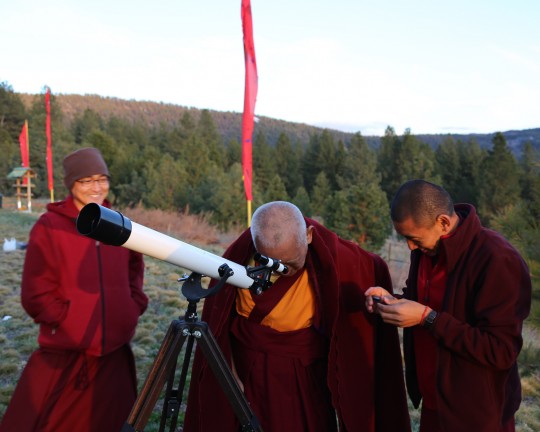
Lama Zopa Rinpoche with Vens. Sherab and Sangpo at Buddha Amitabha Pure Land, Washington, US, April 2014. Photo Ven. Roger Kunsang.
“I would say that compared to others, our lives have been most fortunate,” Lama Zopa Rinpoche instructs in his book Bodhisattva Attitude: How to Dedicate Your Life to Others. ”First of all, many of us have heard the heart of the Buddhadharma, the very essence of the 84,000 teachings of the Buddha, the very precious teaching on the stages of the path to enlightenment (lam-rim) many times. We have even heard this from His Holiness the Dalai Lama himself, who is the real living Chenrezig, the Compassion Buddha manifested in the human form of a monk – the aspect that can most perfectly guide us. Just that alone is most amazing and inexpressible. It is the most unbelievable, rare, fortunate and precious thing that could have happened to us this life.
“Then we have met many other great teachers and unbelievably qualified virtuous friends who preserve the whole entire Buddhadharma – the Lesser Vehicle, Mahayana Paramitayana and Mahayana Tantrayana teachings. Particularly, many of us older students have met and received teachings and initiations from Lama Yeshe, who was kinder than all the numberless past, present and future buddhas and whose holy name is extremely rare and difficult to express.
“So really, if we look at what has happened to us so far in this life, it is most amazing to have met many qualified virtuous friends who can reveal the complete path to enlightenment from their own experience. Can you imagine how most unbelievably fortunate our lives have been?”
You can read more from the chapter “The Teachings: Everything Depends on Your Attitude” from the book Bodhisattva Attitude: How to Dedicate Your Life to Others by Lama Zopa Rinpoche and published by the Lama Yeshe Wisdom Archive.
Learn more about FPMT spiritual director Lama Zopa Rinpoche and his beneficial activities by visiting Rinpoche’s webpage, where you will find links to Rinpoche’s schedule, new advice, recent video, photos and more.
- Tagged: advice, lama zopa rinpoche
- 0
22
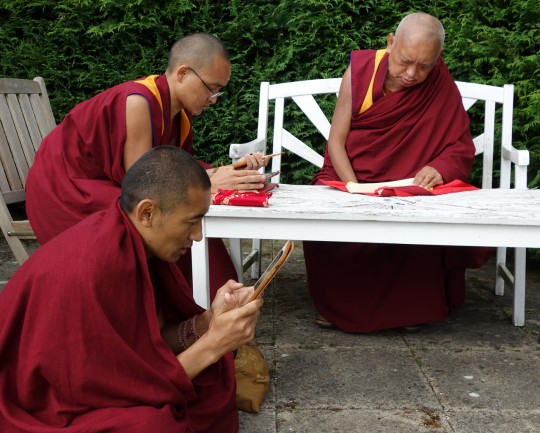
Lama Zopa Rinpoche with Vens. Sangpo and Sherab doing prayers for the future retreat center Land of Joy, UK, July 2014. Photo by Ven. Roger Kunsang.
“A retreat place is not for gaining power like black magic, it’s not for a honeymoon or holiday. Also it is not a place in which to be spaced out,” Lama Zopa Rinpoche advised in 2007.
“The whole purpose of a retreat place is to subdue the mind and to actualize the lam-rim up to enlightenment. It is a place for a holiday from negative karma, a holiday from the three poisonous minds and the self-cherishing thought, a holiday from the self-grasping of the person and phenomena, a holiday from the wrong concepts: non-devotional thought towards the guru up to the subtle dual view of white, increasing, attainment.”
Lama Zopa Rinpoche is the spiritual director of the Foundation for the Preservation of the Mahayana Tradition (FPMT), a Tibetan Buddhist organization dedicated to the transmission of the Mahayana Buddhist tradition and values worldwide through teaching, meditation and community service.
- Tagged: advice, lama zopa rinpoche, retreat
- 0
21
“Guru devotion is the quickest way to collect the most extensive merit, the means to achieve enlightenment,” Lama Zopa Rinpoche once told a group of students at Kopan Monastery. “Of course, the main thing is having the right motivation, bodhicitta, but having a pure mind of guru devotion, with no negative mind arising toward the guru – which is very heavy negative karma – is also very important.
“A negative attitude, such as a thought of giving up respect, even just thinking, ‘What is the use of this teaching?’ creates negative karma; one breaks the samaya vows. A kind of pollution comes, and whatever you offer becomes negative and can invite sickness or obstacles. So, I think, the most important thing is keeping samaya, not doing any wrong thing, not letting heresy arise, having negative thoughts, or losing faith. Lost faith is very heavy. Also, it is important not to break the root pratimoksha vows.
“So much emphasis is placed on guru devotion because, with very strong guru devotion, there is no hardship in following the guru’s advice; it becomes so easy to follow any advice given. …”
You can read more from this teaching on “Guru Devotion” on the page “Advice on Guru Devotion,” part of Lama Yeshe Wisdom Archive’s “Lama Zopa Rinpoche’s Online Advice book.”
Learn more about Lama Zopa Rinpoche, spiritual director of the Foundation for the Preservation of Mahayana Tradition (FPMT), and Rinpoche’s vision for a better world. Sign up to receive news and updates.
- Tagged: advice, guru devotion, lama zopa rinpoche
- 0
20
“Bodhichitta is thinking to benefit all sentient beings, to free them from suffering and to bring them to full enlightenment, therefore we have to achieve enlightenment, therefore we do this practice, this action, so in this way all the time we are dedicating for other sentient beings. So this child you are taking care of is one of the sentient beings,” Lama Zopa Rinpoche wrote to a student who was concerned about her Dharma practice after having a child. “We always dedicate our practice for the most precious sentient beings, from whom all our happiness comes – all our happiness from beginningless rebirth up to now, even this small happiness, comfort, even if we are feeling hot but then serenely the wind blows on our head and we feel cool, so even including that, or if we are thirsty and we find water to drink.
“All the future happiness, not only samsaric happiness, pleasure, but ultimate happiness, liberation from samsara, full enlightenment, peerless happiness, the state of omniscient mind; so all of that we receive from numberless hell beings, numberless hungry ghosts and numberless animals – that means from numberless fish in the ocean, even the large ones, the whales, then also the smallest ones that we can’t see with our eyes, but only with a microscope; every single ant, every single bird, every single butterfly, every single cockroach – they are numberless in each realm, not just in one universe but there are numberless universes, so each universe has numberless [beings]. We receive all our past, present and future happiness from numberless human beings, numberless suras, numberless asuras and numberless intermediate state beings. All the past, present and future happiness we receive from every single sentient being.
“That includes your child. So all your past, present and future happiness, everything comes from this child. Therefore the child, your baby, is the most precious, most kind, most wish-fulfilling one to you, and as well as that, every single other sentient being – every insect in the house and outside in the forests, on the ground, in the water, and flying in the sky. Therefore, the best Dharma is to cherish the sentient beings and to serve them, to free them from suffering and bring them to happiness. …”
You can read the complete advice ”Taking Care of Your Child with Compassion,” a new addition to “Lama Zopa Rinpoche’s Online Advice Book,” on the Lama Yeshe Wisdom Archive website.
More information, photos and updates about FPMT spiritual director Lama Zopa Rinpoche can be found on Rinpoche’s webpage. If you’d like to receive news of Lama Zopa Rinpoche via email, sign up to Lama Zopa Rinpoche News.
19
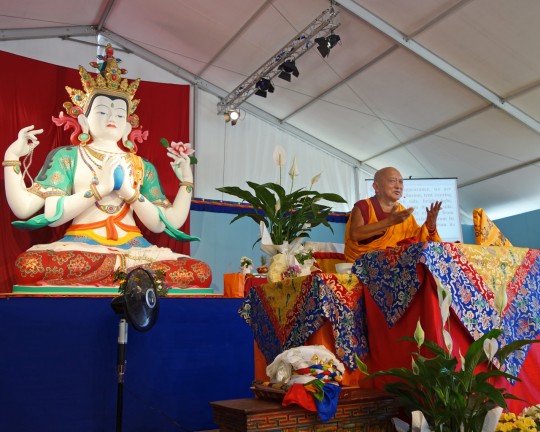
Lama Zopa Rinpoche teaching at Istituto Lama Tzong Khapa, Italy, June 2014. Photo by Ven. Roger Kunsang.
“In reality, even if we believe that we will live for a long time, that we have so many years to live – like 100 years or more, and maybe after 100 years, we expect another hundred years (I’m joking) – in reality, there is nobody who has lived who has not died,” Lama Zopa Rinpoche wrote to the mother of a student, who was worried about death. “Even this big earth has to perish after another great eon. Since every person who is born in this world is under the control of karma and delusion, there is nobody, nobody, since human beings started until now, who has lived without death. There is nobody.
“Buddha has no death, because there is no cause of death. The cause of death is not outside but inside –karma and delusions. Buddha removed this inconceivable eons ago, because he purified the delusions and even the subtle obscurations which interrupt the omniscient mind, so it is impossible for the Buddha to experience death. There is no old age, no sickness, no death for him at all, but he showed holy deeds, passing away in the sorrowless state. If Buddha did not show death, then we would not appreciate his teachings and we would become very lazy. Buddha showed death to destroy the wrong concept of permanence of our lives, which are impermanent, and also to show us that we need to practice Dharma, because of suffering and the cause of suffering. …”
You can read the entire letter “The Cause of Death” on the Lama Yeshe Wisdom Archive website.
Learn more about FPMT spiritual director Lama Zopa Rinpoche and his beneficial activities by visiting Rinpoche’s webpage, where you will find links to Rinpoche’s schedule, new advice, recent video, photos and more.
- Tagged: advice, death, lama zopa rinpoche
- 0
18
In February 1990, Lama Zopa Rinpoche gave a series of teachings as part of the Third Enlightened Experience Celebration, which took place in Bodhgaya, India. His discourse was based on the 15th-century text Opening the Door of Dharma. During the teachings, Lama Zopa Rinpoche described how he came across the text in his late twenties and what it meant to him:
“In 1974, while I was staying in the cave of the previous Lawudo Lama in the Solu Khumbu region of Nepal, I decided to check through all the texts that had belonged to him. They were mostly Nyingma texts relating to the practices of various deities, but there was one text that is a fundamental practice of all four Tibetan sects. The text I found was Opening the Door of Dharma: The Initial Stage of Training the Mind in the Graduated Path to Enlightenment.
“A collection of the advice of many Kadampa geshes, Opening the Door of Dharma is by Lodrö Gyaltsen, a disciple of both Lama Tsongkhapa and Khedrub Rinpoche, one of Lama Tsongkhapa’s two spiritual sons. This text describes the initial stage of thought transformation, or mind training – in other words, the first thing to practice if you want to practice Dharma.
“Only when I read this text did I come to know what the practice of Dharma really means. During all the years of my life up until then I had not known. Practicing Dharma is usually regarded as reading scriptures, studying, memorizing, debating, saying prayers, performing rituals, and so forth. It was only when I read this text that I found out how to practice Dharma. I was very shocked that all my past actions had not been Dharma. When I checked back, all those past years of memorizing and saying prayers were not Dharma. From all those years, nothing was Dharma. …”
Rinpoche’s discourse on Opening the Door of Dharma can be read in the book The Door to Satisfaction, edited by Vens. Ailsa Cameraon and Robina Courtain and published by Wisdom Publications. A PDF of the “Foreward” by Kirti Tsenshab Rinpche, “Editor’s Preface” and “Prologue” is available from Wisdom online. The “Prologue” includes Rinpoche’s account of his education, meeting Lama Yeshe and returning to Lawudo as well as the significance of his discovery of Opening the Door of Dharma.
Lama Zopa Rinpoche is the spiritual director of the Foundation for the Preservation of Mahayana Tradition (FPMT), a Tibetan Buddhist organization dedicated to the transmission of the Mahayana Buddhist tradition and values worldwide through teaching, meditation and community service.
14

Lama Zopa Rinpoche with the new Amitabha Buddha statue at Buddha Amitabha Pure Land, Washington, US, July 2014. Photo by Ven. Roger Kunsang.
“It is not good to leave statues or stupas completely empty. To leave a statue empty is like offering nothing to the buddhas and can create obstacles,” Lama Zopa Rinpoche instructs in “Essential Mantras for Holy Objects.”
“Therefore, it is important to put something inside of the statue, even as little as a few mantras and some incense. This is also true when offering statues to your teachers, there should always be something placed inside of them for auspiciousness. If you need to wait a while until your statue/stupa can be properly filled and consecrated, then roll up a copy of the Four Dharmakaya Relic mantras, or the five powerful mantras and place them inside the statue with some incense for the time being. …”
You can read more in FPMT Education Services’ “Essential Mantras for Holy Objects.” Also visit Education Services’ page on “Holy Objects” for more advice and resources.
More information, photos and updates about FPMT spiritual director Lama Zopa Rinpoche can be found on Rinpoche’s homepage. If you’d like to receive news of Lama Zopa Rinpoche via email, sign up to Lama Zopa Rinpoche News.
- Home
- News/Media
- Study & Practice
- About FPMT Education Services
- Latest News
- Programs
- New to Buddhism?
- Buddhist Mind Science: Activating Your Potential
- Heart Advice for Death and Dying
- Discovering Buddhism
- Living in the Path
- Exploring Buddhism
- FPMT Basic Program
- FPMT Masters Program
- FPMT In-Depth Meditation Training
- Maitripa College
- Lotsawa Rinchen Zangpo Translator Program
- Universal Education for Compassion & Wisdom
- Online Learning Center
- Prayers & Practice Materials
- Overview of Prayers & Practices
- Full Catalogue of Prayers & Practice Materials
- Explore Popular Topics
- Benefiting Animals
- Chenrezig Resources
- Death & Dying Resources
- Lama Chopa (Guru Puja)
- Lama Zopa Rinpoche: Compendium of Precious Instructions
- Lama Zopa Rinpoche: Life Practice Advice
- Lama Zopa Rinpoche Practice Series
- Lamrim Resources
- Mantras
- Prayer Book Updates
- Purification Practices
- Sutras
- Thought Transformation (Lojong)
- Audio Materials
- Dharma Dates – Tibetan Calendar
- Translation Services
- Publishing Services
- Teachings and Advice
- Find Teachings and Advice
- Lama Zopa Rinpoche Advice Page
- Lama Zopa Rinpoche: Compendium of Precious Instructions
- Lama Zopa Rinpoche Video Teachings
- ༧སྐྱབས་རྗེ་བཟོད་པ་རིན་པོ་ཆེ་མཆོག་ནས་སྩལ་བའི་བཀའ་སློབ་བརྙན་འཕྲིན།
- Podcasts
- Lama Yeshe Wisdom Archive
- Buddhism FAQ
- Dharma for Young People
- Resources on Holy Objects
- Ways to Offer Support
- Centers
- Affiliates Area
- Teachers
- Projects
- Charitable Projects
- Make a Donation
- Applying for Grants
- News about Projects
- Other Projects within FPMT
- Support International Office
- Projects Photo Galleries
- Give Where Most Needed
- FPMT
- Shop
Subscribe to FPMT News
Translate*
*powered by Google TranslateTranslation of pages on fpmt.org is performed by Google Translate, a third party service which FPMT has no control over. The service provides automated computer translations that are only an approximation of the websites' original content. The translations should not be considered exact and only used as a rough guide.We are not compelled to meditate by some outside agent, by other people, or by God. Rather, just as we are responsible for our own suffering, so are we solely responsible for our own cure. We have created the situation in which we find ourselves, and it is up to us to create the circumstances for our release. Therefore, as suffering permeates our life, we have to do something in addition to our regular daily routine. This “something” is spiritual practice or, in other words, meditation.
The Purpose of Meditation
Lama Yeshe Wisdom Archive







